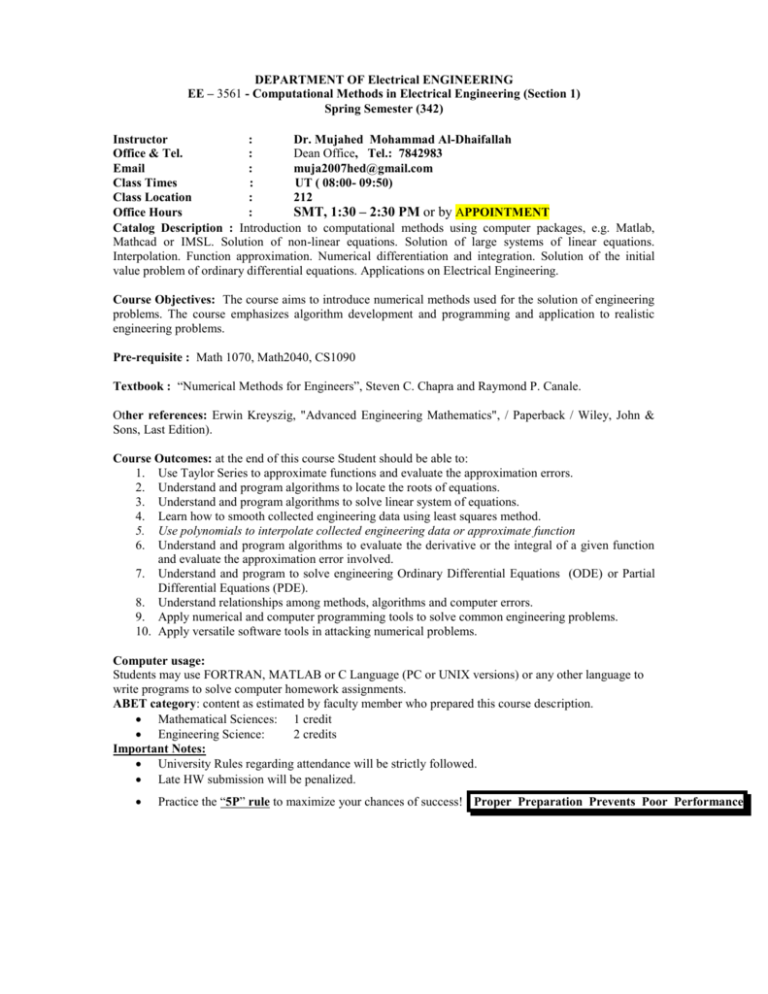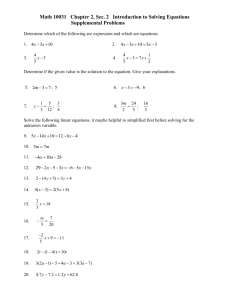File
advertisement

DEPARTMENT OF Electrical ENGINEERING EE – 3561 - Computational Methods in Electrical Engineering (Section 1) Spring Semester (342) Instructor : Dr. Mujahed Mohammad Al-Dhaifallah Office & Tel. : Dean Office, Tel.: 7842983 Email : muja2007hed@gmail.com Class Times : UT ( 08:00- 09:50) Class Location : 212 Office Hours : SMT, 1:30 – 2:30 PM or by APPOINTMENT Catalog Description : Introduction to computational methods using computer packages, e.g. Matlab, Mathcad or IMSL. Solution of non-linear equations. Solution of large systems of linear equations. Interpolation. Function approximation. Numerical differentiation and integration. Solution of the initial value problem of ordinary differential equations. Applications on Electrical Engineering. Course Objectives: The course aims to introduce numerical methods used for the solution of engineering problems. The course emphasizes algorithm development and programming and application to realistic engineering problems. Pre-requisite : Math 1070, Math2040, CS1090 Textbook : “Numerical Methods for Engineers”, Steven C. Chapra and Raymond P. Canale. Other references: Erwin Kreyszig, "Advanced Engineering Mathematics", / Paperback / Wiley, John & Sons, Last Edition). Course Outcomes: at the end of this course Student should be able to: 1. Use Taylor Series to approximate functions and evaluate the approximation errors. 2. Understand and program algorithms to locate the roots of equations. 3. Understand and program algorithms to solve linear system of equations. 4. Learn how to smooth collected engineering data using least squares method. 5. Use polynomials to interpolate collected engineering data or approximate function 6. Understand and program algorithms to evaluate the derivative or the integral of a given function and evaluate the approximation error involved. 7. Understand and program to solve engineering Ordinary Differential Equations (ODE) or Partial Differential Equations (PDE). 8. Understand relationships among methods, algorithms and computer errors. 9. Apply numerical and computer programming tools to solve common engineering problems. 10. Apply versatile software tools in attacking numerical problems. Computer usage: Students may use FORTRAN, MATLAB or C Language (PC or UNIX versions) or any other language to write programs to solve computer homework assignments. ABET category: content as estimated by faculty member who prepared this course description. Mathematical Sciences: 1 credit Engineering Science: 2 credits Important Notes: University Rules regarding attendance will be strictly followed. Late HW submission will be penalized. Practice the “5P” rule to maximize your chances of success! Proper Preparation Prevents Poor Performance # Course Outcomes 1 Use Taylor Series to approximate functions and evaluate the approximations error Apply and program algorithms to locate the roots of equations. Apply and program algorithms to solve linear system of equations Smooth engineering collected data using least squares method Use polynomials to interpolate collected engineering data or approximate functions Apply and program algorithms to estimate the derivative or the integral of a given function or engineering data and evaluate the approximation error. Understand and program to solve engineering Ordinary Differential Equations (ODE) Understand relationships among methods, algorithms and computer errors. Apply numerical and computer programming to solve common engineering problems. Apply versatile software tools in attacking numerical problems 2 3 4 5 6 7 8 9 10 Method of Assessment* H, Q, E Program Outcomes ** a, e, k H, Q, E ,P H, Q, E H, Q, E H, Q, E a, e, k a, e, k a, e, k a, e, k H, Q, E a, e, k H, Q, E,P a, e, k H, Q, E a, i, k H, P a, i, k P a, i, k * Method of Assessments: H: Homework, Q: Quizzes, E: Exams, P: Projects, L: laboratories. ** EE Program Learning Outcomes: a. Apply knowledge of mathematics, science, and engineering. b. Design and conduct experiments, as well as analyze and interpret data; c. Design a system component, or process to meet desired needs within realistic constraints d. Function as a member of a multi-disciplinary team e. Identify, formulate, and solve control and instrumentation Systems engineering problems f. Understand and respect professional and ethical responsibility g. Communicate effectively both orally and in writing h. Understand the impact of engineering solutions in a global and societal context i. Recognize the need for life-long learning, and an ability to engage in it j. Have a knowledge of contemporary issues k. Use updated techniques, skills and tools of control and Instrumentation Systems engineering throughout their professional careers. Grading : Attendance 5% HWs / Quizzes 10 % Computer Work 5% Major I 10 % topics 1,2,3 ( Date: TBA) Time: TBA) Major II 10 % topics 4,5,6 ( Date: TBA) Time: TBA ) Final 60 % ( Date set by Registrar, Duration= 2 hours ) TOPICS No. of Lectures(50 min.) __________________________________________________________________________ 1. Introductory material: 3 Absolute and relative errors, Rounding and chopping, Computer errors in representing numbers (sec 3.1-3.4). Review of Taylor series (sec 4.1), ------------------------------------------------------------------------------------------------------------ --------------------2. Locating roots of algebraic equations: 4 Graphical Methods ( Sec 5.1), Bisection method (Sec 5.2), Newton method (sec 6.2), Secant method (sec 6.3), ----------------------------------------------------------------------------------------------------------------- ---------------3. Systems of linear equations: 4 Naïve Gaussian elimination(sec 9.2) Gaussian elimination with scaled partial pivoting ---------------------------------------------------------------------------------------------------------------- ----------------4. The Method of Least Squares; 3 Linear Regression (Sect 17.1), Polynomial Regression (Sect 17.2) ---------------------------------------------------------------------------------------------------------------- ----------------5. Interpolation: 4 Newton’s Divided Difference method (Sec. 18.1), Lagrange interpolation (Sec 18.2), Inverse Interpolation (Sec 18.4) 6. Numerical Differentiation: 3 Estimating derivatives and Richardson’s Extrapolation (sec. 23.1-23.2). --------------------------------------------------------------------------------------------------------------------------------7. Numerical Integration: 4 Trapezoidal rule (sec. 21.1), Romberg algorithm (sec 22.2). -------------------------------------------------------------------------------------------- -----------------------------------8. Ordinary differential equations: 5 Euler’s method (sec 25.1), Improvements of Euler’s method (sec 25.2), Runge-Kutta methods (sec. 25.3), Methods for systems of equations (sec 25.4) ---------------------------------------------------------------------------------------------------------------------------------




